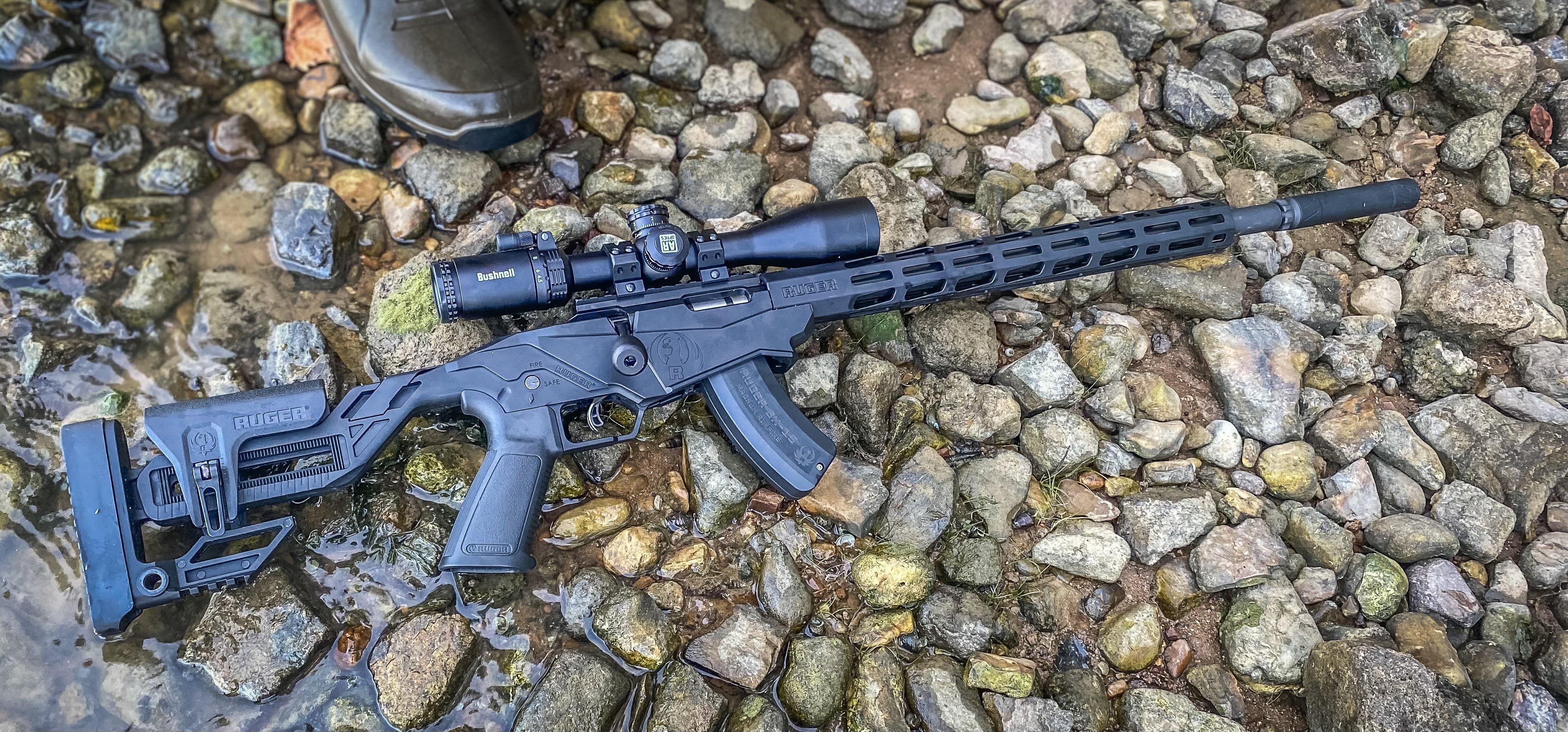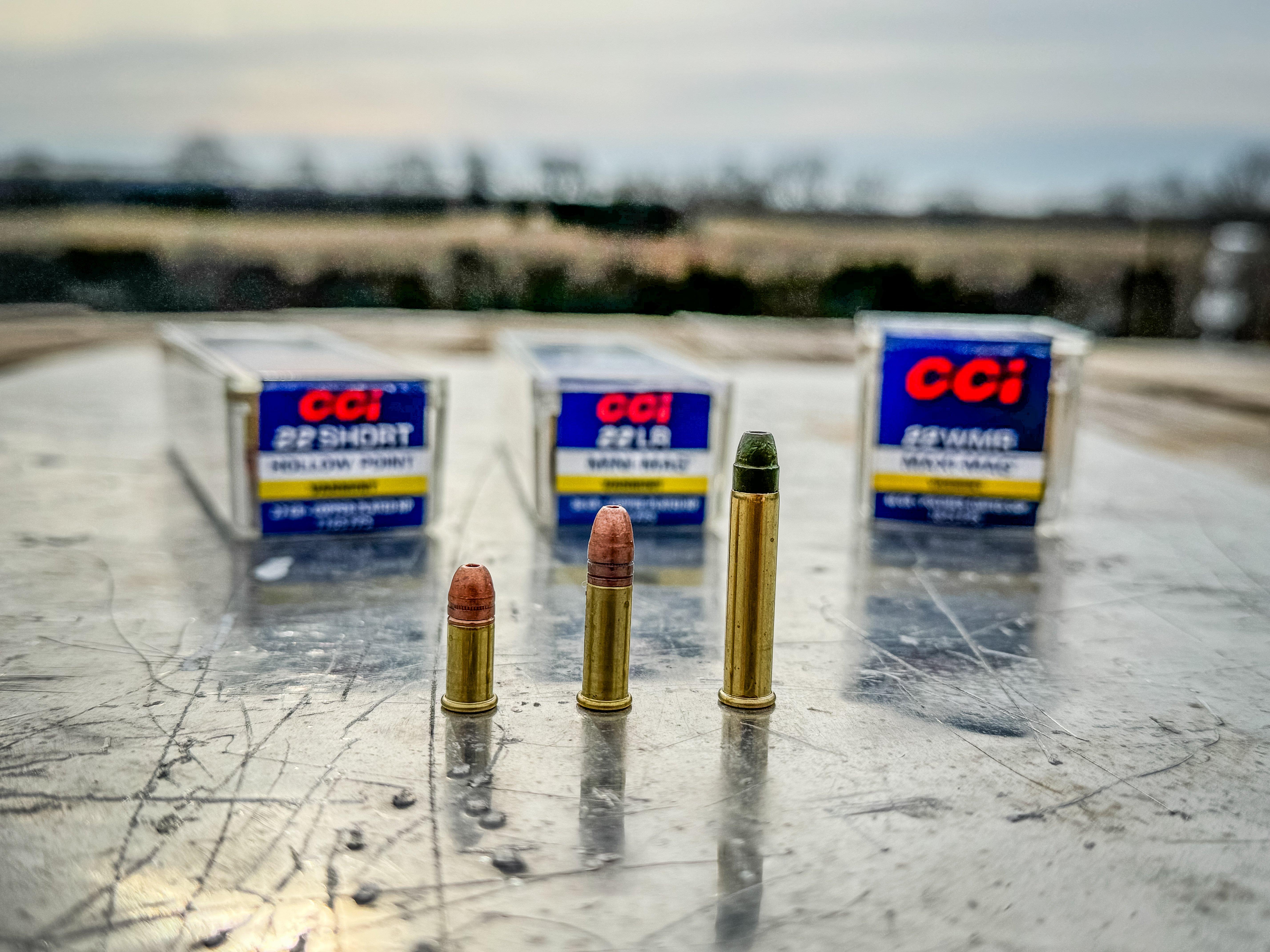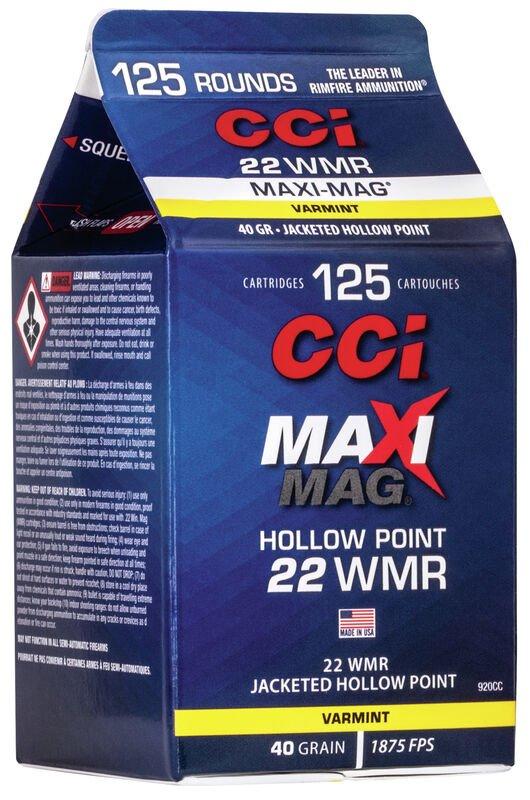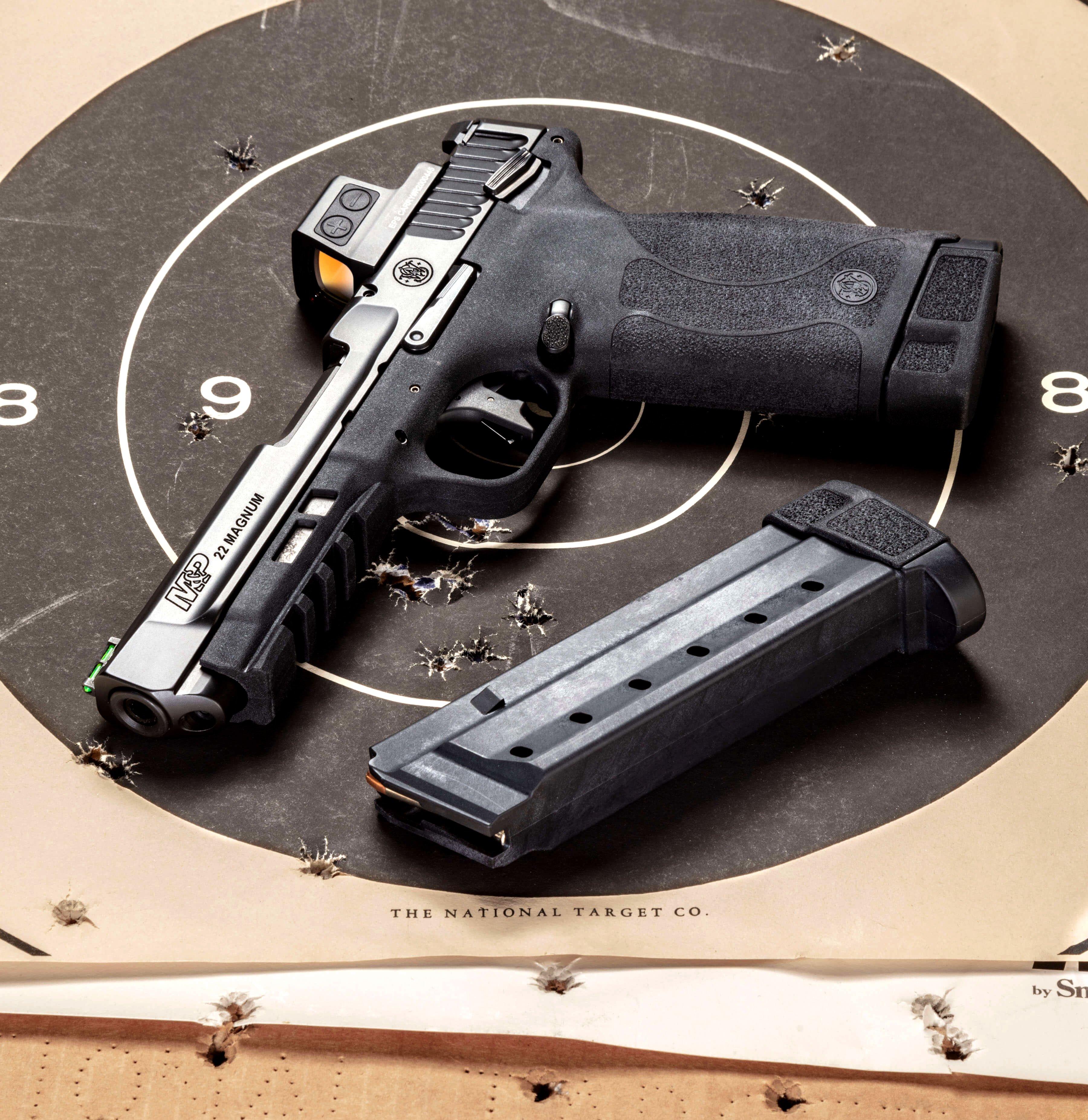The .22 WMR shoots faster, flatter, and packs more punch than the .22 Long Rifle in both handguns and rifles. Is it the perfect rimfire round?
My son and I were easing our way down a big timbered hardwood ridge on a late January day in search of a squirrel or two. A flash of red up ahead caught my attention as a big fox squirrel scrambled up a towering oak nearly 70 yards away. When he got to the top and stopped to survey the open woods around him, I leveled my crosshairs just below his ear and squeezed the trigger on my Ruger Precision Rimfire.
The big bull squirrel seemed to take forever to tumble to the ground. The nearly 80-yard shot would have likely been a pass or a miss with any of my .22 Long Rifle guns. But I was hunting with a .22 Mag, a cartridge that is more than up to the challenge of a precision long-range shot.

The .22 WMR can be accurate at distances far beyond what the .22 LR can achieve. Image by Potroast Pendley
Released in 1959, the .22 Winchester Magnum Rimfire — known more commonly as the .22 Mag or .22 WMR, is essentially an elongated .22 LR. It’s a handy cartridge, capable of taking small- to medium-sized game out to 150 yards, and it is surprisingly accurate, even at longer distances. With the Ruger Precision bolt action, I can usually punch steel targets at 300 yards and beyond on a calm day.
The cartridge was formed by lengthening the .22 LR’s case from .613-inch to 1.055 inches. The case was also widened slightly by 0.024 inches. With the new case dimensions, the WMR holds roughly twice the powder charge as the LR. The wider case means that .22 WMR won’t chamber in guns designed for .22 LR. And, while LR rounds will chamber in WMR firearms, they can’t be safely fired. The loose case fit allows gas to escape into the chamber, often blowing back on the shooter, and regularly resulting in split cases.

The .22 WMR shown alongside the .22 Long Rifle and .22 Short. Image by Michael Pendley
The increased powder charge and pressure offered a true magnum counterpart to the legendary .22 LR. The .22 WMR fires a similar 40-grain roundnose bullet at 1,900 fps, a full 700 fps faster than the parent cartridge.
That increased velocity means the WMR hits harder, with over 300 foot-pounds of energy at the muzzle verses 140 for the LR. It also shoots flatter, dropping 11 inches less at 150 yards than the LR with a similar bullet. Where the WMR really shines is hunting at extended ranges. It carries almost as much energy at 140 yards as the LR has at the muzzle.

Lighter bullets like this 30-grain VNT leave the muzzle at a blistering fast 2,200 fps. Image by CCI
In addition to increased range, there is a much wider selection of bullet constructions for the .22 WMR, with several jacketed hollowpoint offerings for serious small game and varmint hunters. Bullet weights range from 30-grain speedsters. like the Speer TNT that leaves the muzzle at a blistering 2200 fps, all the way up to 50-grain selections like the Federal Game Shock. Bullet styles range from polymer tips to jacketed hollow points to solids. This wide selection makes it easy to customize your load to your intended target.
USES:
Hunting
There’s no denying the .22 WMR will handle just about any small game on the planet. A body shot on a squirrel or rabbit with a hollow point or polymer tipped bullet will leave you with less meat than you should have at the skinning table, but the extended range of the WMR makes it a great choice for tall timber and long shots. Just stick to head shots and you won’t damage any meat at all. I’ve also found that round nose or jacketed soft-point bullets like the CCI Gamepoint tend not to expand as much in small game, causing less damage as they pass through but still offering quick, clean kills.
Pest Control
Crows in your garden? Raccoons around your feeders? Woodchucks, rock chucks, or prairie dogs digging around your barn or in your pasture? Muskrats tunneling through your pond dam? The .22 WMR is tailormade for solving varmint issues like these. The extended range and flatter trajectory mean that you can effectively control nuisance game from up to 150 yards away.
Predator Hunting
While the .22 WMR doesn’t have the stopping power of any .22 centerfire, it carries more than enough energy to take foxes, bobcats, and even large coyotes at over 100 yards with a well-placed shot. And it’ll do it without the pelt damage the speedier centerfires sometimes cause.

The .22 WMR is adequate for predator hunting at moderate distances. Image by Marcin Perkowski
Where the WMR really shines for predators is when regulations limit you to rimfires or shotgun only, which is a common rule in many states on public land and for nighttime hunting.
***Don’t Miss: *HOW TO PICK THE RIGHT SOUNDS WHEN CALLING COYOTES
Target Shooting
Practice makes perfect when it comes to shooting. There’s no substitute for range time when it comes to muscle memory. While each pull of the trigger on a WMR will cost you more money than a .22 LR, it will still be a fraction of even the cheapest centerfire ammo. Match your rifle style and scope to your favorite big-game rifle, and you can practice long-range shooting all day for just a few dollars.

While more costly than .22LR, the .22 WMR still offers great value for longer range target practice. Image by CCI
Handguns
Just as with rifles, handgun velocity and energy are greatly increased in the WMR. Taurus, Smith & Wesson, Heritage, and Ruger all make excellent revolvers chambered in the round. Rock Island’s XTM in .22 WMR feels exactly like a full frame 1911 in hand, making it a great choice for draw and fire practice if you normally carry a 1911 for self defense. And Kel-Tec, Smith & Wesson, and Walther all make lightweight semi-auto handguns with 30-round magazines, making them ideal for bug-out or survival kits. WMR handguns make the perfect trap line companions when you are targeting larger predators like coyotes, bobcats, badgers, and wolves.

Don’t overlook the .22 WMR as a handgun option that is perfect for practice, hunting, pest control and even self-defense. Image by Smith & Wesson
***Don’t Miss: *10 COYOTE TRAPPING MISTAKES BEGINNERS MAKE
Self Defense
Some scoff at the notion of a rimfire for self-defense, but improvements in bullet design are bringing the WMR into the conversation. Federal Premium’s Punch Personal Defense round loads a nickel-plated, 45-grain lead-core bullet that is propelled at extreme velocities and engineered to minimize expansion to hit critical penetration depths — even through heavy clothing and with short-barrel handguns. The bullet design and nickel plating means they will reliably feed in a wide range of firearm designs. Hornady offers the Critical Defense .22 WMR Rimfire Ammo with a 45grain FTX bullet for reliable penetration.
While a rimfire might not be the first choice for a self-defense gun, it’s better than no gun at all. And, with concealed carry permit applications on the rise, there are many shooters who aren’t comfortable with the muzzle rise and recoil of a large-caliber centerfire pistol. Older shooters with arthritis often find it difficult to aim and fire more powerful handguns. The .22 WMR produces very mild recoil and is easy for most shooters to manage. As mentioned above, some .22 WMR handguns offer significantly higher capacities than their centerfire counterparts.
All of this adds up to making the .22 WMR one of the most versatile rounds on the market. If you are shopping for a new rimfire, be it handgun or rifle, give one a shot. There’s good reason it’s still going strong after 65 years.












